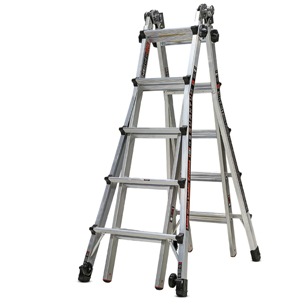Step ladders are self-supporting portable ladders that do not have adjustable lengths, flat steps, and hinged designs for easy storage. They are designed for single-user use only. The length of a stepladder can vary from 4 feet to 20 feet along the side rail. Step Ladders shorter than 4 feet are considered Step Stools. Approximately 2 feet below the top of the ladder is the highest standing level on a step ladder. The highest standing level must be indicated on the specifications label on the side rail of the product. As a result, when planning your job, the maximum work height is determined by adding the user’s height to the highest standing point of the stepladder.

The four side rails of a stepladder must be supported on level ground. A stepladder shouldn’t be selected if this condition doesn’t exist at the work site. Stepladders must always be used with their bases spread fully open and their spreaders locked. You should not use step ladders as single ladders or in the partially-opened position. To prevent tipping the ladder over sideways due to overreaching, the user must climb the ladder or work with their bodies near the middle. The ladder should be set up close to the work area. The ladder should never be moved without first descending, moving the ladder, and then climbing back up. The ladder should be secured against sideways motion before mounting it from the side or stepping from one ladder to another.
It is important to refrain from stepping or standing higher than the level indicated on the label marking the highest standing level in order to avoid losing your balance and falling off the stepladder. Furthermore, the user should not step on the Top Cap or bucket/pail shelf. Always face the ladder and maintain a firm hold when climbing or descending. While climbing, do not carry any other objects in your hands.
The rear bracing of a stepladder are not designed for climbing or standing and should not be used for either. Special step ladders with steps on both the front and back are available and are designed for two people to use at the same time. Before using the ladder, make sure the anti-slip feet at the bottom of the side rails are present and in excellent working order. The ladder should not be used on ice, snow, or other slippery surfaces unless adequate traction is provided. In order to gain more height, a stepladder should never be placed on other things such as boxes, barrels, scaffolds, or other unstable bases.
Step Ladder Proper Care
When the ladder is first acquired and every time it is put into use, it must be thoroughly inspected. If the climbing and gripping surfaces have been exposed to oil, grease, or slippery materials, clean them. The state of the anti-slip feet, as well as working parts, bolts, rivets, step-to-side rail connections, and the condition of the anti-slip feet, must all be examined. If structural damage, missing pieces, or any other potentially dangerous flaw is discovered, the ladder must be abandoned or expertly fixed.
Ladders exposed to high temperatures, such as those found in a fire, may lose their strength. Ladders exposed to corrosive substances such as acids or alkali compounds may also suffer from chemical corrosion, resulting in a loss of strength. These ladders should be taken out of service.
Ladders must be appropriately supported when transported on vehicles equipped with ladder racks. Ladder overhang beyond the rack’s support points should be kept to a minimum. To minimize the impacts of vibration, chafing, and road shock, the support points should be made of wood or rubber-covered tubing. The road shock will be substantially reduced if the ladder is secured to each support point. Ladder storage racks should have enough supporting points to prevent sagging, which could cause the ladder to distort. While the ladder is in storage, no other materials should be placed on it.










